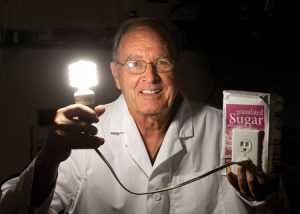
Retired Chemistry professor Gerald Watt and his BYU colleagues have found a new way to generate electricity from sugar.
A spoonful of herbicide helps sugar break down—in a most delightful way, according to BYU researchers.
They’ve developed a fuel cell—basically a battery with a gas tank—that harvests electricity from glucose and other sugars known as carbohydrates. Carbs, the human body’s preferred energy source, could someday power our gadgets, cars, and homes.
“Carbohydrates are very energy rich,” says recently retired chemistry professor Gerald D. Watt (BS ’62). “What we needed was a catalyst that would extract the electrons from glucose and transfer them to an electrode.”
The surprising solution turned out to be a common weed killer, as reported by Watt and his colleagues in the October issue of the Journal of the Electrochemical Society. The effectiveness of this cheap and abundant herbicide is a boon to fuel cell technology; researchers have been trying to create viable, carb-based fuel cells for more than 20 years. By contrast, hydrogen-based fuel cells, like those developed by General Motors, require costly platinum as a catalyst.
The study reported experiments that yielded a 29 percent conversion rate, or the transfer of 7 of the 24 available electrons per glucose molecule.
“We showed you can get a lot more out of glucose than other people have done before,” says chemical engineering professor Dean R. Wheeler (BS ’96), lead faculty author on the paper. “Now we’re trying to get the power density higher so the technology will be more commercially attractive.”
Pursuing an even stronger sugar high, the BYU team’s next step is to ramp up the power through design improvements. So far they have built only small prototypes that can’t power much more than an LED light, but they have doubled the power rate in just a few months. The technology also makes for a clean energy source, as the byproducts, water and carbon dioxide, are absorbed by plants and used to make more glucose—essentially the next batch of fuel. Unlike burning fossil fuels, this technology causes no net increase in carbon dioxide in the atmosphere.






